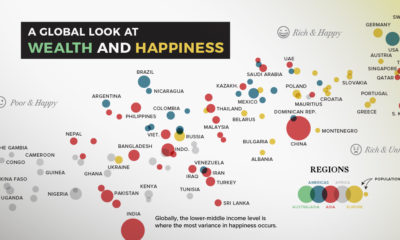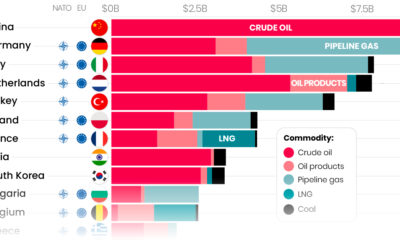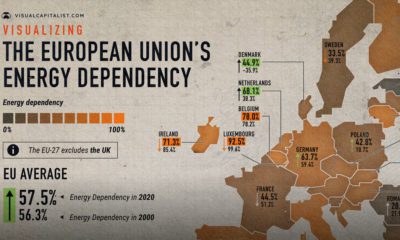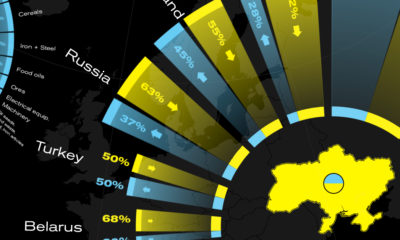In 2018, total global exports exceeded $19 trillion, including specialized goods falling into almost every possible category imaginable. Whether you’re talking about German cars, Bangladeshi t-shirts, Saudi oil, or Swiss milk chocolate, just about anything is available on the world market for a price – and the world’s largest exporting countries aim to take advantage.
Ranked: The 15 Largest Exporters in 2018
Today’s visualization comes to us from HowMuch.net, and it resizes countries based on their most recent export numbers, as per data from the World Trade Organization (WTO). Let’s take a look at how the field breaks down: Leading the list of the world’s largest exporters is China, with a whopping $2.5 trillion of goods sent abroad in 2018. If you add in Hong Kong’s numbers, China holds 15.7% of the global export total — roughly equal to Japan, Netherlands, South Korea, France, and Singapore combined. Coming next on the list is the U.S., which exports about $1.7 trillion of goods each year. After that comes Germany, which is the only other country to export over $1 trillion of goods per year.
Comparing U.S. and Chinese Exports
What does China export, and how does that compare to a more developed economy such as the United States? Using data from MIT’s Observatory of Economic Complexity, we can see the broad breakdown of exports in both countries: On first glance, it’s clear that China’s exports are reliant on one heavy-hitting category (Machines) to drive a whopping 48.5% of total export value. Within that broad category of machines, there are many narrower categories, including:
Broadcasting equipment (9.6% of total exports) Computers (6.1%) Office machine parts (3.8%) Integrated circuits (3.3%) Telephones (2.6%) Electrical transformers (1.3%) Semiconductor devices (1.2%) Video displays (1.1%)
For the United States, machines are still important at 22.1% of exports, but three other broad categories also surpass the 10% mark: transportation, chemical products, and mineral products. This means the U.S. is generally more diversified in its major exports. For more, see the largest export of each state on this map. on Both figures surpassed analyst expectations by a wide margin, and in January, the unemployment rate hit a 53-year low of 3.4%. With the recent release of February’s numbers, unemployment is now reported at a slightly higher 3.6%. A low unemployment rate is a classic sign of a strong economy. However, as this visualization shows, unemployment often reaches a cyclical low point right before a recession materializes.
Reasons for the Trend
In an interview regarding the January jobs data, U.S. Treasury Secretary Janet Yellen made a bold statement: While there’s nothing wrong with this assessment, the trend we’ve highlighted suggests that Yellen may need to backtrack in the near future. So why do recessions tend to begin after unemployment bottoms out?
The Economic Cycle
The economic cycle refers to the economy’s natural tendency to fluctuate between periods of growth and recession. This can be thought of similarly to the four seasons in a year. An economy expands (spring), reaches a peak (summer), begins to contract (fall), then hits a trough (winter). With this in mind, it’s reasonable to assume that a cyclical low in the unemployment rate (peak employment) is simply a sign that the economy has reached a high point.
Monetary Policy
During periods of low unemployment, employers may have a harder time finding workers. This forces them to offer higher wages, which can contribute to inflation. For context, consider the labor shortage that emerged following the COVID-19 pandemic. We can see that U.S. wage growth (represented by a three-month moving average) has climbed substantially, and has held above 6% since March 2022. The Federal Reserve, whose mandate is to ensure price stability, will take measures to prevent inflation from climbing too far. In practice, this involves raising interest rates, which makes borrowing more expensive and dampens economic activity. Companies are less likely to expand, reducing investment and cutting jobs. Consumers, on the other hand, reduce the amount of large purchases they make. Because of these reactions, some believe that aggressive rate hikes by the Fed can either cause a recession, or make them worse. This is supported by recent research, which found that since 1950, central banks have been unable to slow inflation without a recession occurring shortly after.
Politicians Clash With Economists
The Fed has raised interest rates at an unprecedented pace since March 2022 to combat high inflation. More recently, Fed Chairman Jerome Powell warned that interest rates could be raised even higher than originally expected if inflation continues above target. Senator Elizabeth Warren expressed concern that this would cost Americans their jobs, and ultimately, cause a recession. Powell remains committed to bringing down inflation, but with the recent failures of Silicon Valley Bank and Signature Bank, some analysts believe there could be a pause coming in interest rate hikes. Editor’s note: just after publication of this article, it was confirmed that U.S. interest rates were hiked by 25 basis points (bps) by the Federal Reserve.












